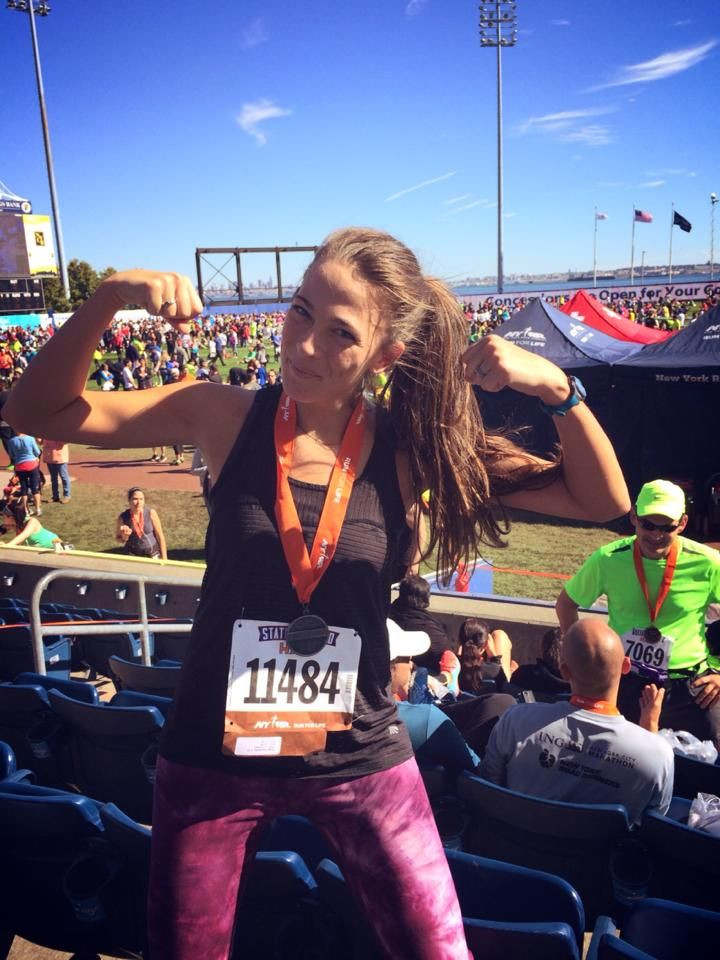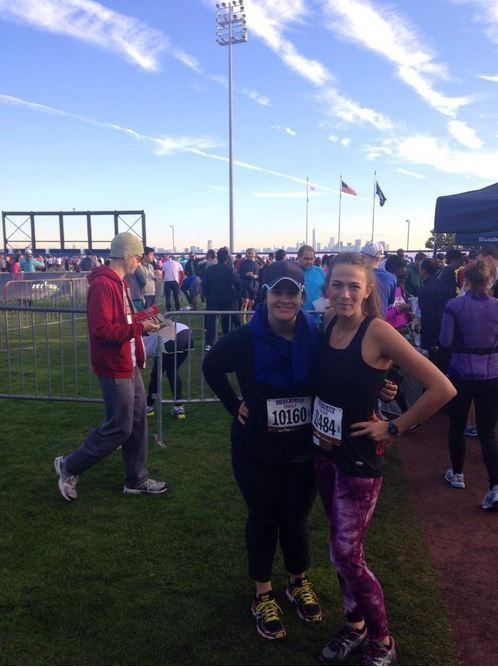What A Half-Marathon Did To Me Mentally And Physically: A Food And Fitness Guide

Only 100 meters left to go. Come on, you can do this, my mind encouraged me as it struggled to drag my legs to a faster pace in the last 0.1 of my half-marathon. I’m tired, but I feel strong. I can’t feel my knees anymore. Why did that guy just cut in front of me. I have to beat him. Ha! Take that! Oh, that was exhausting. That was a bad idea. No, keep going, keep this pace. You got this. I’m tired of talking to myself. I feel crazy. Why’d I do this again? Where am I? I can’t feel my legs.There’s the finish line! Come on, let’s go. Push harder, faster. You’re stronger than this, Jell-O legs!
The pure adrenaline and ecstasy pumping through your body is enough to make you feel invincible as you cross the finish line of a half-marathon, despite your depleted body. After completing my third half-marathon at the New York Road Runners’ Five-Borough Series in State Island, I’ve become all too familiar with the pain and pleasure the race can bring a runner. When I lined up next to the 8,868 other runners at the starting line Sunday morning, I could sense the feeling was mutual.
My colleague recommended the race to me, and a month later we found ourselves nervously prepping and chatting with each other minutes before the gun. The nerves of others are palpable and the comradery between running partners and strangers alike undeniably becomes your new support system to carry you through a course of unexpected rolling hills and turns.

I looked down at my body — had I stretched enough? Followed my diet and training schedule correctly? As I looked out across the water to the New York City skyline, ultra-marathon runner Stan Jensen’s advice ran through my head: “If you undertrain, you may not finish, but if you overtrain, you may not start.” What category did I fall into? I was about to find out as 8:30 a.m. crept its way to signal the next two-plus hours of running.
One of the tricks to running long distances is to master the art of negative splits. This means that you’ve trained your body to run the first half of a race slower than the second half, requiring both planning and patience. According to a survey from Runner’s World, 47 percent of runners manage their pace with a watch, 33 percent feel out their pace, another nine percent use apps, and the rest rely on a running partner, group, heart monitor, or pace wristband.
Personally, from years of high school and college track, it’s ingrained in me to use a watch at all times. However, during half-marathons, I chose to use a pacing app, such as Nike+ to calculate my pace because I’ve found I can’t do math when I’m mentally exhausted from rooting myself on to finish the race.
Running tests your mental strength just as much as it does your physical abilities. Your body will always want to give up, which is why you have to make the mind run the body. Of course, you have to train your body and muscles to respond and deliver the results your mind demands under performance pressure, but the rest is all mental. Running is a constant battle between two voices in your head — one telling you it’s OK to slow down or even stop, while the other one tirelessly screams back, don’t listen to her, keep going. It all comes down to the voice within that wins.
It was around mile 5 I finally stared at the timer and realized I was on pace to beat my last two race times. Only 8.1 more miles to go. This is also around when my knees start to feel the pain of running on pavement. I knew the constant pounding of the road would hurt my joints in the days to follow, and the pace I was keeping would make it hard for my muscles to climb stairs. Thank goodness for elevators and escalators, I reassured myself as I hit the seventh mile marker.

Throughout the race I rotate from drinking water to drinking Powerade at the hydration station tables. Electrolytes are important to keep a runner’s blood sugar up, but the water is absolutely necessary to keep the body as hydrated as possible. At mile 8, a table of energy gel packets made of a sugar, carb, and potassium blend was set up for runners to grab along the way.
I grabbed one and skeptically tried it for the first time, and within minutes I felt a surge of energy just in time to finish the last 5k of the race. It wasn’t until mile 10 that I was a little delirious and the music I was listening to became completely irrelevant. But my mind was acutely aware of every pothole, pebble, and person surrounding me. I don’t know exactly when it happened, but somewhere along the gradual and dauntingly steep hills, my body turned into a machine. I could feel the mechanical lift and drop of my arms moving in sync with my legs, as the muscles, tendons, and ligaments worked together to move my tired bones forward. Finishing is all that matters.
Whether it’s to complete the 13.1-mile goal for the first time or to set a new personal record, there’s something about a half marathon that attracts people. Maybe it’s to support a cause, fulfill a promise of getting in shape that year, or just to see how far you can push your body. Last year, nearly two million Americans crossed the finish line of half-marathons, becoming the fastest growing distance race in the U.S., since 2003, according to the 2014 Annual Half-Marathon Report by Running USA.

My Running Fuel And Fitness Routine:
There is an old adage that should be retired by now, and that’s carbing up the night before a big race. After growing up on soccer and track teams from middle school through college, the ritualistic pasta party became part of the sport itself. I’ve learned since then, the key is to carb up two days before the big race so you’re not running with a belly full of heavy, super-absorbent carbohydrates. If you don’t fully digest by the time you arrive to the starting line, you’ll be fighting your body to pull blood from your digestive system to fuel your muscles, which is exactly why we’ve been warned not to swim right after eating.
Keeping this in mind, I chose to fill up the Friday before my race with carbs — but not just any carbs. Complex carbohydrates are made of three or more linked molecules of sugar, while simple sugars are comprised of only one or two sugars. Complex carbs, such as potatoes, white flour, most breakfast cereals, rice, and pretzels digest fairly quickly and have a high glycemic index, which means they can elevate sugar levels within 15 minutes, according to Mayo Clinic. Complex carbs with low glycemic levels, such as sweet potatoes, dairy, nuts, fruits, non-starchy vegetables, and whole-grain pasta, take longer to digest, which is why they sustain energy and keep you feeling fuller longer.
On Friday, I had a bowl of Cheerios with almond milk and a cut up banana, followed by a 7-mile run. Each week I incorporated three 4-mile runs and one 6- to 7-mile run, half of it run on the road and the other half on the beach. Not only will running on the beach give your joints a break because of how well the sand absorbs each footfall, but it also burns 30 percent more calories. Your calf and oblique muscles constantly have to adjust to support the body as you navigate the unstable terrain and slanted shoreline. I always mix two-100 meter sprints in between my long runs in order to train my muscles to handle the sprinting I’ll need to complete the last .1 mile of my half marathon.
When I got home, I rolled out my mat for a 20-minute hatha yoga session, which focuses on breathing and stretching more than exercising the muscles. Yoga and strength training at the gym should be incorporated into every runner’s workout routine in order to build the muscles our body needs to take on a long and enduring run. Afterward, my lunch was a big bowl of comfort food in the form of chicken noodle soup, supplying me with the carbs and protein I needed to get me through my second afternoon workout: Zumba.
This high-energy, hour-long dance workout helped me gauge how strong my lungs and legs were and helped me stretch properly with my instructor’s help. That night, I fueled up with grilled chicken, sautéed with red peppers and onions, and went to bed early to let my body rest and repair. Protein and sleep are essential for building muscle, and if you’re not into chicken, instead incorporate eggs, almonds, olive oil, salmon, steak, and yogurt before and after workout routines.
When I woke up the day before the race, I made sure to have a healthy blend of proteins, carbs, and fats throughout the day, but I kept it light to help my body digest. I even had two glasses of wine, which is proven to help boost heart, muscle, and bone function thanks to its key compound resveratrol. During every meal, and before and after every workout, I made sure to drink at least 12 ounces (oz.) of water to help my body flush any waste products, adding up to eight 12-oz. glasses of water a day. What you eat the day before matters just as much as what you eat the morning of your race. I chose to eat half of an egg white, cheddar, and tomato breakfast sandwich an hour and a half before my race, while I let my nerves digest and settle in my body.
I realized once I survived the mileage and crossed the finish line on home plate of the New York Yankees minor league team stadium that I had successfully disciplined and achieved my goal by earning a personal record. In those last few moments, I stared up at the spectators rooting us on to finish the straight away and was sad that it was over. After looking at my finishing time and average pace, I couldn’t help but already want more. I couldn't help but want to beat myself all over again.



























